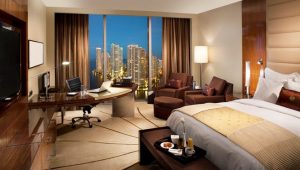
The Westin Denver International Airport Hotel has a lobby that is just steps from the security screening, but the rooms have floor-to-ceiling glass walls with views of the cityscape or the Rocky Mountains. Singapore passengers can walk directly from Terminal 3 at Changi Airport to Crowne Plaza Hotel, a luxury property with a spa, gym, and pool in a courtyard surrounded by tropical foliage.
Lauro Ferroni is the Global Head of Hotels and Hospitality Research at JLL. She says, “These hotels are more than just a place to sleep before an early flight.” They’re designed to reflect the local culture, including on-brand food, beverage, decor, and entertainment. This is a huge change from the airport hotels in the past, where you could have woken up anywhere.
Design meets functionality
Airport hotels were once a necessity for airline passengers who had long layovers or canceled flights. Today, airport hotels are more focused on attracting guests with upscale amenities and modern design. They also offer better connectivity with their next flight.
The Hilton Amsterdam Schipol Airport was designed by Dutch architect Mecanoo and features a geometric exterior with an expansive atrium lobby. The train takes 15 minutes to reach the city center, and the covered walkway from the airport terminal takes 10 minutes.
Ferroni says that the new terminal hotels compete not with hotels near the airport but rather with downtown hotels. To be successful, these hotels must be physically linked to the airport. If you have to take a shuttle to get to the airport from your hotel, you may as well stay in the downtown area.
Direct access to airport terminals could be a deciding factor for business travelers, who are the majority of airport hotel guests. They may also choose to stay in an airport hotel because of the reduced transportation costs and the convenience of the location. Ferroni says that selling to corporate groups is key. Think about day meetings where representatives are flying in to train or conferences where attendees can book back-to-back activities in the same hotel.
Hoteliers understand the importance of focusing on corporate guests. Ferroni says that airport hotels need flexible meeting rooms, such as large ballrooms or smaller breakout spaces. The ability to book day-use rooms could also be useful for passengers who only want to stay for a few hours. For guests to be satisfied, the food and beverages must be of high quality. Fitness rooms in good condition are a popular amenity for business travelers who want to keep fit on the road.
The Business of Airport Hotels
According to hotel data provider STR, the demand for airport hotels around the world increased from 55 million nights to 65 million in 2016.
Ferroni says that there is evidence to suggest that airport hotels located near a terminal are as good as hotels in the city’s upper class. Most major airports without a hotel attached to a terminal have been thinking about getting one.
Developers are planning a higher-tier hotel that will be connected to the domestic terminal of Hartsfield-Jackson Atlanta International Airport. It will also have a rooftop deck with runway views.
Airports can increase their revenue by adding a business-friendly, upscale hotel to their airport. Birmingham Airport, in the UK, has seen a PS100m investment for upgrading passenger services and construction of a four-star, as well as longer-term plans to build a five-star hotel pay off. It’s now a hub for British Airways.
The new airport hotels are a mix of convenience and style.





